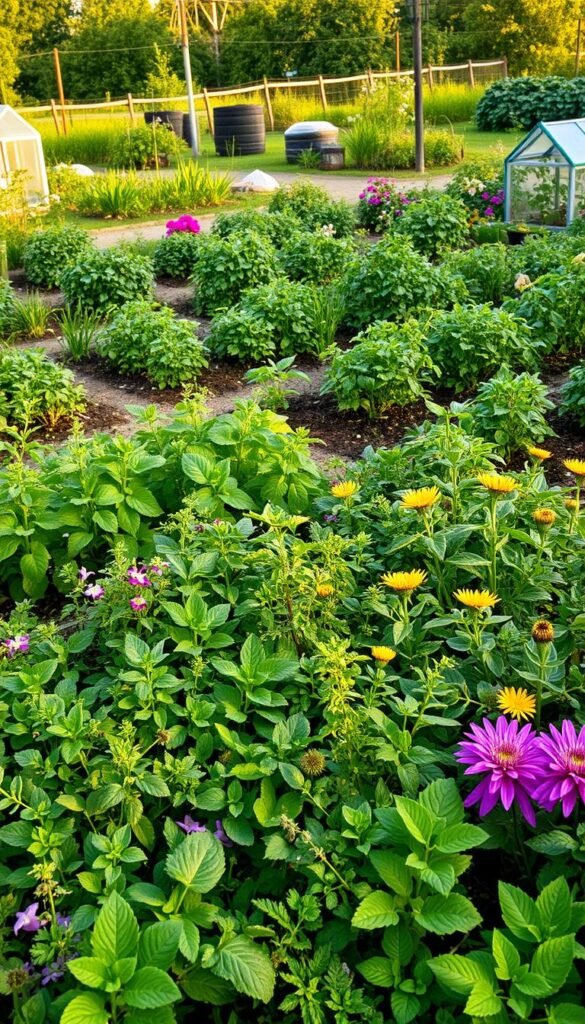Imagine stepping outside to harvest fresh greens and crisp vegetables from your own backyard. Many families dream of reducing grocery bills while enjoying homegrown meals, but figuring out where to begin often feels overwhelming. Let’s explore how to create a productive growing space that fits your lifestyle.
The Frosty Garden team offers a helpful reality check. Their 2,000-square-foot plot provides 15-20% of two people’s yearly food needs – and that’s with 200+ hours of care. This shows even modest plots can make meaningful impacts when managed thoughtfully.
Success starts with matching your ambitions to your available time and energy. Jumping into large projects often leads to burnout. Instead, focus on building skills through small wins. Learn which crops thrive in your climate, master succession planting, and discover preservation methods that suit your schedule.
This guide will show you how to:
- Set achievable targets for your household’s needs
- Design low-maintenance growing systems
- Balance food production with daily life demands
Remember, every tomato harvested or herb dried brings you closer to food independence. With smart planning and patience, your plot can become a rewarding source of nourishment – not another chore list item.
Getting Started with a Smaller Garden Foundation
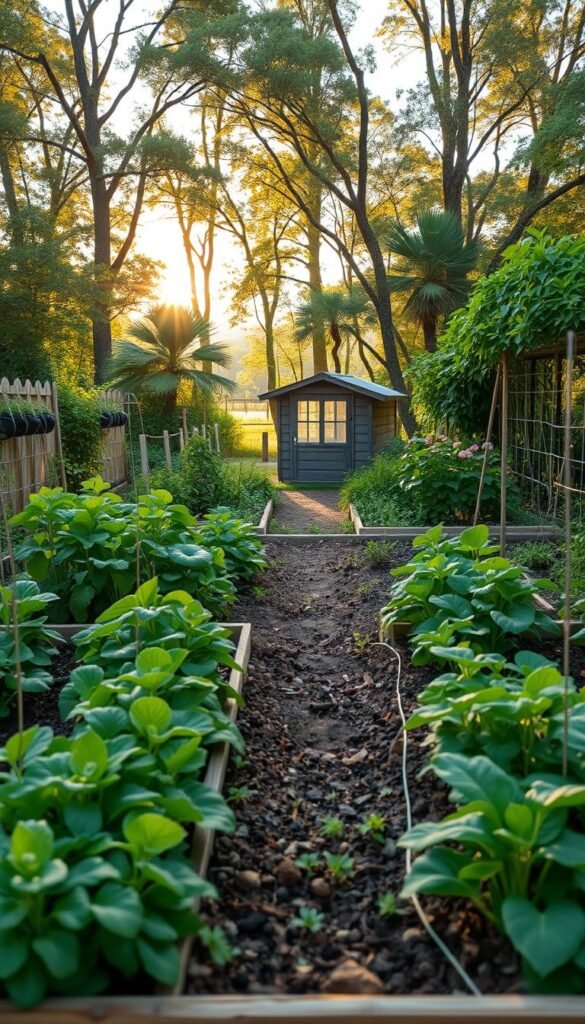
Small spaces can yield big rewards when approached wisely. Beginning with a modest plot lets you focus on what matters most: observing nature’s patterns and building foundational skills. Think of your first growing season as a hands-on workshop where mistakes become valuable lessons.
Understanding Your Garden’s Initial Needs
Every successful growing area starts with three essentials: healthy soil, proper sunlight, and smart plant choices. Test your dirt’s pH level – most vegetables thrive between 6.0-7.0. Track how shadows move across your space through the day. This helps match plants to their ideal spots.
| Focus Area | Small Garden (100-200 sq ft) | Large Garden (500+ sq ft) |
|---|---|---|
| Learning Curve | Master 3-5 plant types | Manage 10+ varieties |
| Maintenance Time | 2-4 hrs/week | 8-12 hrs/week |
| Experimentation | Test 1-2 methods/season | Coordinate multiple systems |
Building Expertise Through Small-Scale Projects
Start with fast-growing greens like spinach or radishes. These quick wins boost confidence while teaching watering rhythms. Try succession planting in one raised bed before expanding. Notice how tomato plants respond to pruning techniques. These micro-lessons create muscle memory for future seasons.
Over time, you’ll develop a gardener’s intuition. You’ll know when soil needs compost by its texture. Recognize pest issues before they spread. This knowledge grows gradually – typically over 2-3 years – through consistent, focused practice.
Essential Planning and Garden Design

A thriving garden starts long before the first seed is planted. Serious food production begins around 1,000 square feet – enough space to grow preservable harvests while allowing smart design. Grab graph paper and colored pencils; your edible landscape takes shape through thoughtful arrangement.
Mapping Your Garden Layout for Success
Sketching your garden plan prevents costly errors. Track sunlight patterns – most vegetables need 6-8 hours daily. Place tall crops like corn north of shorter plants to prevent shading. Leave 3-foot pathways between beds for easy wheelbarrow access. Toolsheds and water sources should sit central to reduce steps.
Selecting the Right Crops and Their Placement
Match plants to your plate. If your family eats 20 lbs of potatoes monthly, dedicate space accordingly. Cluster basil with tomatoes for natural pest control – they’re companion plants that boost each other’s growth. Use vertical space: pole beans climb trellises while lettuce grows below.
Preparing Soil and Garden Beds Effectively
Test your soil using $10 kits from garden centers. Ideal pH ranges from 6.0-7.0 for vegetables. Mix in compost 6 weeks before planting – earthworms will thank you. Raised beds warm faster in spring, while in-ground rows suit large-scale square foot gardening.
Leave expansion zones in your design. As skills grow, you might add berry bushes or cold frames. Good plans evolve – just like your green thumb.
Scaling Up Your Self-Sustaining Garden: Producing More Food with Less Effort
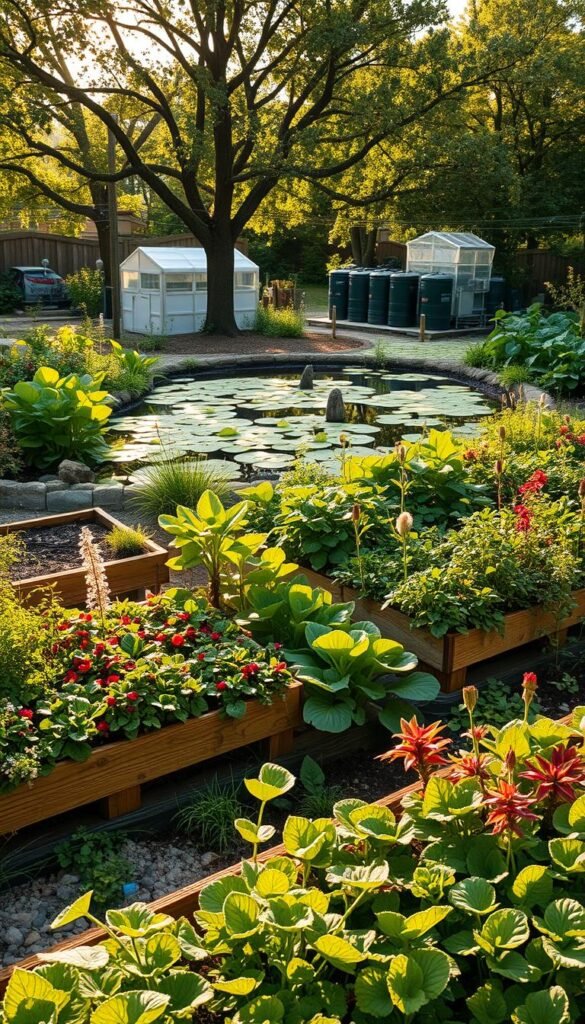
A quarter-acre plot holds surprising potential – enough space to grow 60% of a family’s yearly food needs when designed thoughtfully. This leap from casual growing to meaningful production requires viewing your land as interconnected ecosystems rather than separate plots.
Start by calculating your household’s actual consumption. A family eating 50 lbs of tomatoes annually needs 10-12 plants, not just “some vines.” Pair this math with organic growing principles to build fertile soil that sustains diverse crops.
Effective systems combine:
- Fruit trees attracting pollinators
- Compost cycles feeding vegetable beds
- Poultry controlling pests while fertilizing soil
One Maryland homesteader reports, “Our chickens till weeds between blueberry bushes, while their manure feeds nearby kale.” This integration reduces work while boosting output. Automated drip irrigation and strategic companion planting further minimize daily chores.
Track progress seasonally. Did your squash yield meet targets? Are preserves lasting through winter? Adjust plant varieties and space allocations using real data rather than guesswork. Remember – thriving gardens evolve through observation and adaptation.
Expanding Your Garden Through Innovative Techniques
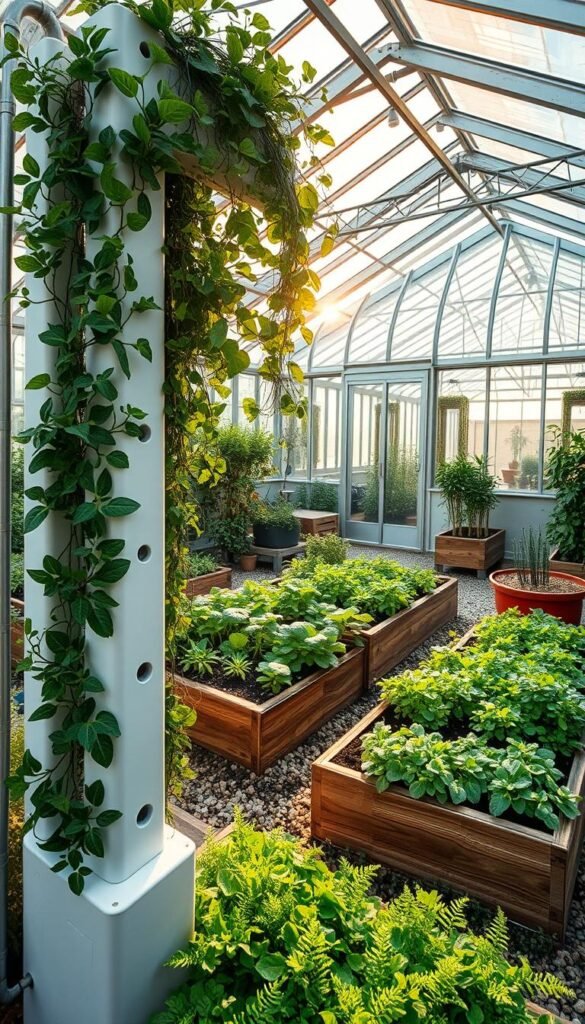
Think beyond traditional plots to maximize your harvests in unexpected places. Creative solutions let you grow more without doubling your workload. The secret lies in adapting methods to your unique environment and available resources.
Exploring Raised Beds, Container Gardens, and Community Plots
Raised beds transform poor soil into productive space. Their elevated design warms faster in spring and prevents soil compaction. Pair them with a smart square foot gardening layout to grow 4x more food than traditional rows.
Containers turn concrete patios into salad factories. Try these ideas:
- 5-gallon buckets for cherry tomatoes
- Window boxes for herbs
- Hanging baskets for strawberries
Community plots offer shared tools and knowledge. One Denver group grows 800 lbs of veggies annually on a vacant lot. Members trade harvests and split maintenance tasks.
Using Natural Resources to Extend Your Growing Space
Sloped yards become terraced gardens for heat-loving plants. Wet areas support watercress or taro. Sunny walls host vertical planters with pole beans climbing upward.
Partner with neighbors needing lawn care. Offer to plant edible gardens in their unused space in exchange for partial harvests. One Wisconsin gardener tripled her tomato yield using three backyards.
Cold climates benefit most from these techniques. Greenhouses made from recycled windows and container gardens indoors keep fresh greens growing year-round. Remember – every square foot counts when you think creatively.
Implementing Crop Rotation and Succession Planting
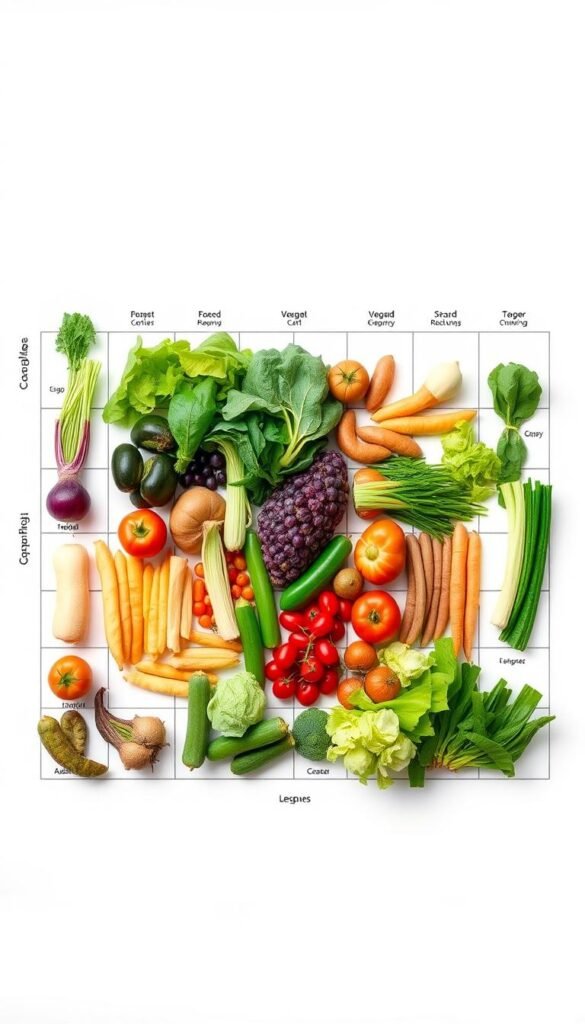
Your soil remembers what you planted last season – and so do pests. Smart growers use this knowledge to their advantage through strategic crop rotation and succession planting. These methods turn your plot into a year-round food factory while keeping dirt healthy.
Why Crop Rotation Matters
Rotating plant families across different rows each year stops pests from setting up camp. Potatoes and squash particularly benefit from this practice. Here’s why:
- Legumes fix nitrogen that corn needs next season
- Tomatoes shouldn’t follow peppers (same plant family)
- Root crops break up soil for leafy greens
One Midwest farmer shares: “Since rotating our three main beds, Colorado potato beetles dropped by 70%.” Track rotations using a simple notebook or digital calendar.
Mastering Succession Planting
Time your plantings like a concert conductor. When garlic finishes in June, sow carrots in its place for fall harvests. Try these combos:
- Spring peas → summer beans → fall kale
- Early radishes → mid-season cucumbers → winter cover crops
Your local growing season dictates exact dates. Those in warmer zones might squeeze in extra cycles, while northerners focus on quick-maturing varieties. Always check seasonal care strategies for timing adjustments.
Keep records of what works. Next year’s planting schedule becomes clearer when you note which successions yielded best. Your soil – and dinner plate – will thank you.
Maximizing Harvest and Storage for Year-Round Food Security
Preserving your harvest transforms summer abundance into winter nourishment. The real magic happens when your growing strategy aligns with storage capabilities. Start by choosing crops that store well naturally – this reduces processing time while keeping pantries full.
Integrating Simple Food Preservation Methods
Root vegetables like potatoes and squash thrive in cool, dark spaces. Store them in breathable crates at 50-60°F for months. For greens and cruciferous vegetables, blanch and freeze within hours of picking. This locks in flavor better than store-bought frozen options.
Canning shines for creating meal-ready jars. Mix garden tomatoes with basil and garlic for instant pasta sauce. Fermenting cabbage into sauerkraut or drying apple slices adds variety to your shelves. One Maine homesteader notes: “Our pressure canner processes 7 quarts at once – perfect for batch cooking.”
Optimizing Storage Solutions for Long-Term Use
Design storage areas based on your climate and harvest volume. Consider these options:
| Method | Best For | Duration | Tips |
|---|---|---|---|
| Root cellar | Root vegetables | 4-6 months | Maintain 90-95% humidity |
| Pantry shelves | Onions, garlic | 2-3 months | Use mesh bags for airflow |
| Freezer | Blanched greens | 8-12 months | Label with dates |
| Fermentation | Cabbage, beans | 6+ months | Check brine levels weekly |
Spread preservation tasks across seasons. Dry herbs in summer, can tomatoes in fall, and ferment kraut in winter. This prevents burnout while keeping your food supply diverse.
Integrating Diverse Crop Systems and Perennial Plants
Diversity isn’t just for ecosystems—it’s your garden’s secret weapon. By blending annual vegetables with long-lasting plants, you create a resilient food network that feeds your family while nurturing the land.
Introducing Fruit Trees and Perennial Varieties
Fruit trees become permanent food producers. Imagine 30 apple or pear trees arranged in rows, their roots stabilizing soil while attracting beneficial insects. Between these woody anchors, grow garlic or carrots—their shallow roots won’t compete with deeper tree systems.
Companion Planting and the Three Sisters Method
The classic trio—corn, beans, and squash—shows nature’s teamwork. Corn stalks support bean vines, while squash leaves shade the ground. This incredible efficiency produces three crops in one space. It’s a perfect example of regenerative organic approaches that build healthier ecosystems.
Balancing Annuals with Perennials for Sustainability
Mix quick-growing annuals with low-maintenance perennial vegetables like asparagus. Artichokes and rhubarb return yearly after establishment, while herbs like thyme spread naturally. This balance reduces replanting work and ensures continuous harvests.
Your garden becomes a layered habitat. Beneficial insects find homes in flowering herbs, while tree canopies protect tender plants below. Start small—add two fruit trees and one companion bed this season. Watch how these partnerships flourish over time.

